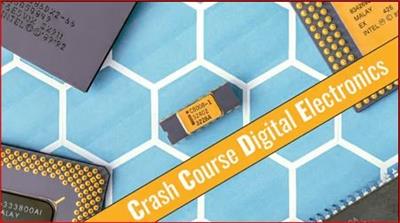Skillshare - Digital Electronics From Transistor to How a Microprocessor Works
- 23.07.2021
- 219

MP4 | Video: h264, 1280x720 | Audio: AAC, 44.1 KHz
Language: English | Size: 2.46 GB | Duration: 4h 7m
This course will teach you digital electronics, starting with the invention of vacuum tubes (in 1904) and early programming languages, until the modern era where powerful microprocessors can run complex operating systems.
What is the difference between a microcontroller and a microprocessor and how do they work?
How is that possible that in just a century, big and ugly vacuum tubes got replaced by transistors, which then got shrunk to the size of a rice grain and integrated on a piece of silicon, giving birth to the first commercially available microprocessor (the Intel 4004), with a transistor count of just 2,250 and a clock speed of 740kHz, to modern processors (like the M1 chip) with 16 BILLION transistors running on clock speeds higher than 3GHz?
What you will learn:
- The basics of electronics
- Logic Gates
- Negative and Floating Point Numbers, ASCII, UNICODE
- Boolean Arithmetic Using Logic Gates
- Registers and RAM
- Central Processing Unit - CPU
- Arithmetic Logic Unit - ALU
- Instruction Sets
- Advanced CPU Design
- CPU Architectures
- How Programming Languages Were Born
- Assembly Language
- Integrated Circuits
- Microcontrollers
- Operating Systems
It's going to be a long journey, but an interesting and exciting one.
Are you ready to embark upon the Digital Electronics Crusade? Can't wait to see you on board!
Homepage
https://www.skillshare.com/classes/Digital-Electronics-From-Transistor-to-How-a-Microprocessor-Works/1894506500Buy Premium From My Links To Get Resumable Support,Max Speed & Support Me
Download (Uploadgig)
https://uploadgig.com/file/download/34D832c83054fe0e/s8nny.Digital.Electronics..From.Transistor.to.How.a.Microprocessor.Works.part1.rar
https://uploadgig.com/file/download/De0E6193c1c76fc4/s8nny.Digital.Electronics..From.Transistor.to.How.a.Microprocessor.Works.part2.rar
https://uploadgig.com/file/download/672E0182079f91b7/s8nny.Digital.Electronics..From.Transistor.to.How.a.Microprocessor.Works.part3.rar
Download ( Rapidgator )
https://rapidgator.net/file/70e75af512f68f1e80544cb9107c4bb9/s8nny.Digital.Electronics..From.Transistor.to.How.a.Microprocessor.Works.part1.rar.html
https://rapidgator.net/file/b4c47a94c39fbcccf45c43539e4ad390/s8nny.Digital.Electronics..From.Transistor.to.How.a.Microprocessor.Works.part2.rar.html
https://rapidgator.net/file/ca0e89a061ff2dfe6fac03f19f5fecc0/s8nny.Digital.Electronics..From.Transistor.to.How.a.Microprocessor.Works.part3.rar.html
Download ( NitroFlare )
https://nitro.download/view/095AD6F4D35A76F/s8nny.Digital.Electronics..From.Transistor.to.How.a.Microprocessor.Works.part1.rar
https://nitro.download/view/023BDEC1C4E24B8/s8nny.Digital.Electronics..From.Transistor.to.How.a.Microprocessor.Works.part2.rar
https://nitro.download/view/190D7080DFA4F04/s8nny.Digital.Electronics..From.Transistor.to.How.a.Microprocessor.Works.part3.rar
https://uploadgig.com/file/download/34D832c83054fe0e/s8nny.Digital.Electronics..From.Transistor.to.How.a.Microprocessor.Works.part1.rar
https://uploadgig.com/file/download/De0E6193c1c76fc4/s8nny.Digital.Electronics..From.Transistor.to.How.a.Microprocessor.Works.part2.rar
https://uploadgig.com/file/download/672E0182079f91b7/s8nny.Digital.Electronics..From.Transistor.to.How.a.Microprocessor.Works.part3.rar
Download ( Rapidgator )
https://rapidgator.net/file/70e75af512f68f1e80544cb9107c4bb9/s8nny.Digital.Electronics..From.Transistor.to.How.a.Microprocessor.Works.part1.rar.html
https://rapidgator.net/file/b4c47a94c39fbcccf45c43539e4ad390/s8nny.Digital.Electronics..From.Transistor.to.How.a.Microprocessor.Works.part2.rar.html
https://rapidgator.net/file/ca0e89a061ff2dfe6fac03f19f5fecc0/s8nny.Digital.Electronics..From.Transistor.to.How.a.Microprocessor.Works.part3.rar.html
Download ( NitroFlare )
https://nitro.download/view/095AD6F4D35A76F/s8nny.Digital.Electronics..From.Transistor.to.How.a.Microprocessor.Works.part1.rar
https://nitro.download/view/023BDEC1C4E24B8/s8nny.Digital.Electronics..From.Transistor.to.How.a.Microprocessor.Works.part2.rar
https://nitro.download/view/190D7080DFA4F04/s8nny.Digital.Electronics..From.Transistor.to.How.a.Microprocessor.Works.part3.rar
Links are Interchangeable - No Password - Single Extraction